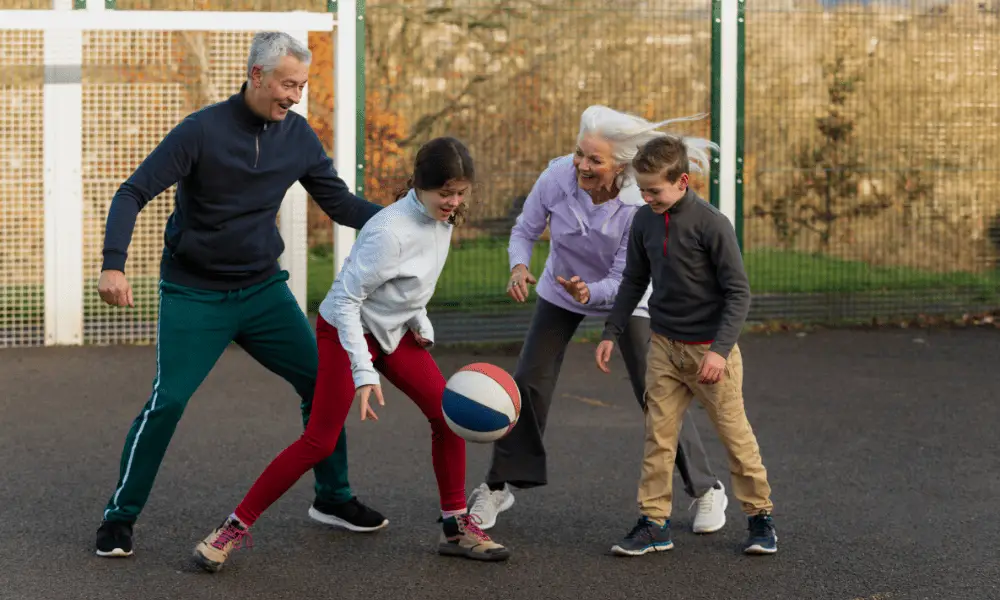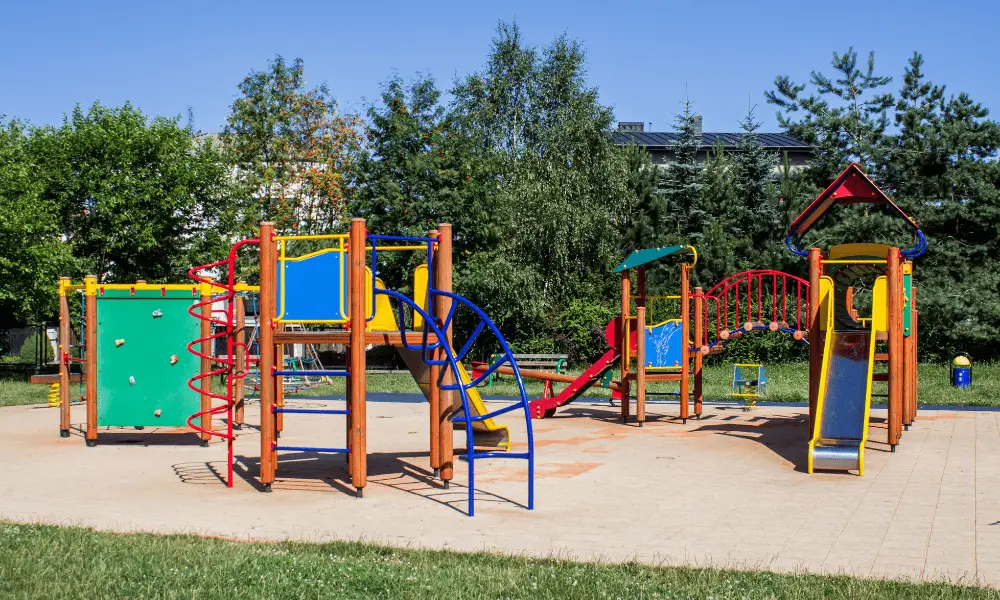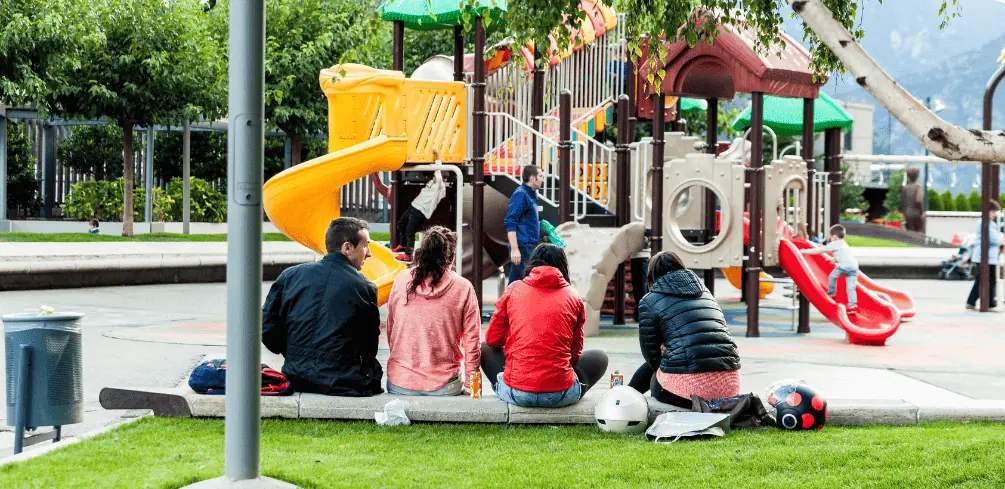As the sun shines down on a lively playground, children of all ages laugh and play, exploring their imaginations and testing their physical limits.
You might wonder, is there an age where it’s time to hang up the monkey bars for good?
The truth is, determining when someone is too old for the playground involves more than just a number; it’s about recognizing safety guidelines and psychological and social factors, as well as understanding the benefits of play for all ages.
Safety Guidelines and Age Limits For Playgrounds

When considering safety guidelines and age limits, it’s important for you to keep in mind that playground equipment is typically designed for specific age groups.
Age restrictions on playgrounds are meant to ensure children have a safe and fun experience while playing.
To provide an enjoyable environment, playground designers create separate areas with age-appropriate equipment for toddlers (ages 2-5), school-age children (ages 5-12), and sometimes even teenagers.
Supervised play is crucial in these settings to guarantee that kids are using the right equipment and playing safely with their peers.
Understanding child development plays a significant role in determining what type of playground activities are suitable for specific age groups.
For instance, younger children need equipment that helps them develop gross motor skills like climbing and balancing, while older kids benefit from activities that require more coordination, strength, and problem-solving abilities.
It’s essential to respect the age recommendations posted on the playground because they are based on research about developmental milestones as well as safety considerations.
A primary concern when letting your child play at a playground is ensuring their safety by choosing appropriate equipment according to their age group.
By following age restrictions and encouraging supervised play, you can help prevent accidents or injuries from occurring due to misuse of equipment or interactions between children of varying ages.
Be aware of your child’s abilities and limitations when selecting a playground so they can enjoy themselves while staying safe in an environment tailored to their needs.
Psychological and Social Factors for Playgrounds

As you navigate the jungle gym of life, remember that psychological and social factors play a crucial role in determining the appropriate age for enjoying the swings and slides.
Child development is an essential consideration when assessing whether your child is too old for playground activities.
Peer interactions also have a significant impact on your child’s experience at the playground, as they can either enhance or hinder their overall enjoyment and personal growth.
To paint a picture for you, consider these two scenarios:
Understanding both scenarios will help you determine if your child has outgrown the playground experience based on psychological and social factors rather than strictly adhering to an arbitrary age limit.
It’s essential to pay attention to how your child feels while at the playground – do they still enjoy it?
Are they learning new skills?
Or do they seem disinterested or uncomfortable?
Keep communication open with them about what activities interest them most while always prioritizing safety guidelines.
By considering all these aspects, you’ll ensure that your child enjoys recreational experiences that promote healthy growth and development throughout their childhood years without feeling restricted by societal norms or expectations surrounding age-appropriate activities.
Benefits of Play for All Ages

You’ll find that engaging in play has numerous benefits for individuals of all ages, promoting not only physical health but also fostering creativity, problem-solving skills, and social interactions.
Ageless playtime can create opportunities for intergenerational bonding, allowing grandparents to connect with their grandchildren and adults to reminisce about their childhood experiences.
Additionally, participating in age-appropriate activities can help maintain cognitive function and overall well-being throughout one’s life.
| Physical Benefits | Cognitive Benefits | Social Benefits |
|---|---|---|
| Improved coordination and balance | Enhanced problem-solving skills | Strengthened relationships |
| Increased flexibility and strength | Boosted creativity and imagination | Development of communication skills |
| Cardiovascular fitness | Preservation of cognitive function as we age | Opportunities for intergenerational bonding |
As you consider the benefits of play for people of all ages, it’s essential to maintain a focus on safety and child development.
For example, when selecting playground equipment or activities, ensure they are age-appropriate; younger children may require smaller structures with simpler challenges, while older kids might enjoy more complex climbing apparatuses or interactive games.
Additionally, adult supervision is always recommended when young children are playing in order to promote a safe environment.
By embracing the concept of play at any age, you’re contributing positively to your own well-being as well as those around you. Intergenerational bonding through shared activities fosters connections that span across generations while creating lasting memories.
So go ahead – let loose your inner child! Whether it’s swinging on a swing set or playing a game with loved ones from different generations – there’s no such thing as being too old for the playground when everyone can benefit from the joy of playtime together.
Inclusive Playgrounds for All

Inclusive playgrounds provide pure pleasure and endless enjoyment for everyone, ensuring each individual feels welcomed, valued, and capable of participating in the fun.
These playgrounds are designed with universal design principles in mind so that children of all ages and abilities can engage in play together.
Sensory integration is a key component of inclusive playgrounds, as it supports children’s development by providing opportunities for them to explore different textures, sounds, and experiences through play.
To help you enjoy the benefits of an inclusive playground experience, consider these suggestions:
Remember that age-appropriate recommendations should always be followed when visiting any type of playground. Focus on safety by supervising play at all times and selecting equipment suitable for your child’s developmental stage.
By embracing the concept of inclusive playgrounds and prioritizing accessibility, you’re helping to create a world where every child has the chance to thrive through meaningful connections made during their most cherished moments – those spent having fun together.
Alternatives for Older Individuals

Just because you’re all grown up doesn’t mean you can’t still find joy and connection in alternative play spaces designed for older individuals!
Age-appropriate activities and senior-friendly spaces are becoming more prevalent as communities recognize the importance of providing engaging environments for people of all ages.
These alternatives promote physical activity, social interaction, and mental stimulation while ensuring safety and comfort for older participants.
Senior-friendly spaces often include low-impact exercise equipment, walking paths, comfortable seating areas, and opportunities for social interaction through games such as bocce ball or shuffleboard.
These elements provide a safe environment where seniors can stay active without the risk of injury that may come with traditional playground equipment.
Additionally, incorporating intergenerational activities within these spaces encourages connections between younger generations and their elders, fostering learning experiences and shared enjoyment.
Adapting public parks to accommodate age-specific needs is essential in creating inclusive communities that promote overall well-being.
By offering accessible options tailored to older individuals’ preferences and capabilities, we foster an environment where everyone feels welcome to engage in recreational activities regardless of age.
So go ahead – explore these alternative play spaces designed just for you, connect with others, and enjoy life at every stage!
Conclusion
So, age ain’t nothing but a number when it comes to enjoying playtime. Keep safety guidelines and child development in mind, and you’ll be set for a fantastic time at the playground.
Remember, inclusive playgrounds and alternative activities are available for everyone to relish the benefits of play.
So go on, get out there and have fun – because you’re never too old for a little playtime!





